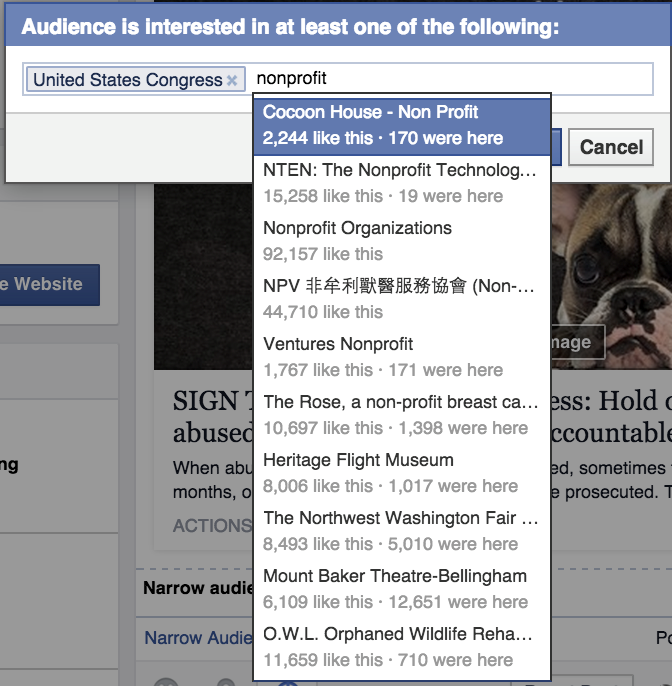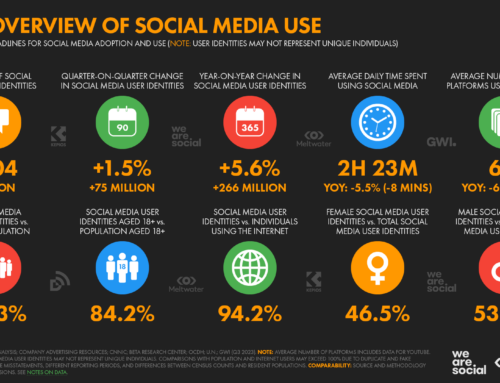
Drew Bernard
Learn how to find your ideal audience on Facebook in this month’s guest post by Drew Bernard of ActionSprout. ~Kristina
Guest Post by Drew Bernard, Founder and CEO of ActionSprout
Facebook targeting is one of the most powerful ways nonprofit page managers can increase reach. The social network’s incredibly accurate targeting options for ads have long made it easy to control spend. Now page mangers can take advantage of those same targeting tools on organic content.
Facebook is always working to deliver users only those posts they are likely to engage with. Enabling page mangers to target organic posts gives them a say in the targeting process.
The new organic post Interest targeting feature gives you a great way to target specific groups of people with specific social actions (petitions, fundraising appeals, etc.). In this article, we’ll talk about both paid Interest targeting for advertising as well as organic Interest targeting.
According to Facebook, “Interest targeting lets you define your ideal audience by their interests, hobbies and Pages they like on Facebook.” This information is collected from people’s Timelines, the Pages they like, apps they use, ads they’ve clicked on and other activities on and off of Facebook. Interests may also factor in demographics such as age, gender and location. Given all these options, let’s take a closer look at the dials and knobs we can turn to make Facebook Interest targeting work for your organization:
Ad Interest Targeting
When creating an ad, the audience section is where you can choose to target people based on their interests. The interests section provides keyword suggestions and shows you how many people are reachable with a given set of keywords. While Facebook recommends using keywords that will give you a minimum reach of 10,000, you should base your targeting on your specific goals. More on that in a minute.

Interests allow you to target people based on their profile information, apps used, Pages liked, and more. You can browse through Facebook’s suggested categories, or start typing and Facebook options will appear. As you begin adding interests, more will be recommended. Remember that they are cumulative, not exclusive, so adding more interests will include more people, not fewer.
You can also target supporters based on websites they have visited or Facebook Pages they are fans of. For example, if your mission is cleaning a local river, you might target people who are fans of local river rafting guides and/or have visited a magazine or blog on the topic. When paying to promote a post, narrowing in on a specific niche audience gives you greater financial control over your ad spend while maximizing potential outcomes as you are targeting those people most likely to be interested in taking an action in support of your cause.
As you walk through the options, remember that people on Facebook can adjust their ad preferences to control how Facebook uses information about them (both on and off of Facebook), which affects the ads Facebook shows them.
Organic Post Interest Targeting
In December Facebook announced a fantastic new Interest targeting option for organic posts. An option exclusively for fans of your Page, Interest targeting is available to all Pages where the Targeting and Privacy setting is enabled.

Simply click on the targeting icon when you create a new post, choose Interests and enter your interest area keywords.

Which to Use When
Ad Interest targeting is particularly interesting and helpful to nonprofits looking to grow their email list or their Facebook page. It is a good way to target potential supporters from a field of people whose interests complement your organization, making them ideal fellow travelers in the path to achieving your mission. Conversely, Organic Post Interest targeting is a great tool when you are looking to promote content that appeals to a subset of your audience and when you want to influence who Facebook will deliver it to.
Use Interest targeting paid advertising to get new fans or reach new audiences and then organic post targeting moving forward to maximize the results of both your organic and boosted posts. From ‘donate now’ to ‘sign the petition’, be sure to create a matching call to action that moves the audience further down the path to a meaningful relationship with your organization.
Less Spray and Pray
I’ve advocated for years that to maximize your (time and money) investment, targeting your audience should be a central tenet of your Facebook marketing. Interest targeting lets you do this in a way that allows you to find and solicit those individuals whose passions are similar to your organizational mission. Moreover, with Facebook’s algorithm favoring content that has higher engagement rates, targeting your content to people who are more likely to care and engage with it should help boost overall content exposure.
Said another way, if you currently struggle with getting your content in the News Feed of your fans and followers, Organic Paid Interest targeting could provide your content the boost it needs. Though it sounds like you are limiting the distribution (which you are), you are putting the content in front of the group of people most likely to engage with it, in turn boosting engagement rates and the likelihood your content will be rewarded by the Facebook algorithm, and shown to more people.
Track, Measure, Improve, Repeat
I recommend creating separate campaigns for different interest areas that you target, allowing you to individually track and measure campaign success by interest area. This will allow you to see which interest areas are most engaged and likely to take action, which are less likely to do so, and if there is a content strategy that works best among your audience’s interest areas. Use this analysis to constantly improve your content and hone your targeting to maximize audience engagement.
Facebook features many targeting options for organizations looking to build their audience and grow deeper in community with their fans and followers. Interest targeting allows organizations to find people who share their passion and then engage them with campaigns tailored to those specific interest areas. Organizations that find success with Interest targeting do so with campaigns that seek to support specific organizational objectives, whether that be growing an email list to increasing fundraising. Interest targeting can play an instrumental role in growing your supporter base and provide a mechanism for soliciting specific actions from as Facebook defines them, “precisely the right people”.
Drew Bernard is the founder and CEO of ActionSprout.com where he helps nonprofits and political campaigns further their mission by engaging supporters in social media. You can find him on Twitter @DrewBernard






